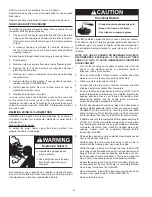
15
provide combustion, ventilation and dilution air.
unusually tight Construction
In unconfined spaces in buildings, infiltration may be adequate
to provide air for combustion, ventilation and dilution of flue
gases. However, in buildings of unusually tight construction (for
example, weather stripping, heavily insulated, caulked, vapor
barrier, etc.) additional air must be provided using the methods
described in the Confined Space section that follows.
Confined spaCe
A Confined Space is one whose volume IS leSS THAN 50 cubic
feet per 1,000 btu/hr (4.8 cubic meters per kW) of the total input
rating of all appliances installed in the space.
Openings must be installed to provide fresh air for combustion,
ventilation and dilution in confined spaces. The required size for
the openings is dependent on the method used to provide fresh
air to the confined space AND the total btu/hr input rating of all
appliances installed in the space.
exhaust fans
Where exhaust fans are installed, additional air shall be provided
to replace the exhausted air. When an exhaust fan is installed
in the same space with a water heater, sufficient openings to
provide fresh air must be provided that accommodate the
requirements for all appliances in the room and the exhaust fan.
Undersized openings will cause air to be drawn into the room
through the water heater’s vent system causing poor combustion.
Sooting, serious damage to the water heater and the risk of fire
or explosion may result. It can also create a risk of asphyxiation.
louvers and grilles
The free areas of the fresh air openings in the instructions that
follow do not take in to account the presence of louvers, grilles or
screens in the openings.
The required size of openings for combustion, ventilation and
dilution air shall be based on the “net free area” of each opening.
Where the free area through a design of louver or grille or screen
is known, it shall be used in calculating the size of opening
required to provide the free area specified. Where the louver and
grille design and free area are not known, it shall be assumed
that wood louvers will have 25% free area and metal louvers and
grilles will have 75% free area. Non motorized louvers and grilles
shall be fixed in the open position.
air reQuirements
Breathing Hazard - Carbon Monoxide Gas
Install water heater in accordance with
the Instruction Manual and NFPA 54 or
CAN/CSA-B149.1.
To avoid injury, combustion and ventilation
air must be taken from outdoors.
Do not place chemical vapor emitting
products near water heater.
Breathing carbon monoxide can cause brain damage or
death. Always read and understand instruction manual.
For safe operation an adequate supply of fresh uncontaminated
air for combustion and ventilation must be provided.
An insufficient supply of air can cause recirculation of combustion
products resulting in contamination that may be hazardous to
life. Such a condition often will result in a yellow, luminous burner
flame, causing sooting of the combustion chamber, burners and
flue tubes and creates a risk of asphyxiation.
Do not install the water heater in a confined space unless an
adequate supply of air for combustion and ventilation is brought
in to that space using the methods described in the Confined
Space section that follows.
Never obstruct the flow of ventilation air. If you have any doubts
or questions at all, call your gas supplier. Failure to provide the
proper amount of combustion air can result in a fire or explosion
and cause property damage, serious bodily injury or death.
unConfined spaCe
An Unconfined Space is one whose volume IS NOT leSS THAN
50 cubic feet per 1,000 btu/hr (4.8 cubic meters per kW) of the
total input rating of all appliances installed in the space. rooms
communicating directly with the space, in which the appliances
are installed, through openings not furnished with doors, are
considered a part of the unconfined space.
Makeup air requirements for the operation of exhaust fans,
kitchen ventilation systems, clothes dryers and fireplaces shall
also be considered in determining the adequacy of a space to
Venting installation
Venting
THe INSTrUCTIONS IN THIS SeCTION ON VeNTING MUST
be FOllOWeD TO AVOID CHOKeD COMbUSTION Or
reCIrCUlATION OF FlUe GASeS. SUCH CONDITIONS CAUSe
SOOTING Or rISKS OF FIre AND ASPHYXIATION.
This heater is not approved for direct vent installation.
Heater must be protected from freezing downdrafts.
remove all soot or other obstructions from the chimney that will
retard a free draft.
Type b venting is required with these heaters. For typical venting
application see TeCHNICAl DATA VeNTING on pages 18 and 19.
This water heater must be vented in compliance with all local codes,
the current revision of the National Fuel Gas Code (ANSI-Z223.1)
and with the Category I Venting Tables.
If any part of the vent system is exposed to ambient temperatures
below 40°F (4.4°C) it must be insulated to prevent condensation.
• Do not connect the heater to a common vent or chimney with
solid fuel burning equipment. This practice is prohibited by
many local building codes as is the practice of venting gas
fired equipment to the duct work of ventilation systems.
figure 11.
figure 12.
• Where a separate vent connection is not available and the vent
pipe from the heater must be connected to a common vent with
an oil burning furnace, the vent pipe should enter the smaller
common vent or chimney at a point above the large vent pipe.
Содержание SBL81120NE
Страница 49: ...49 Model Dimension A SBL 120 154 68 SBL 180 199 250 A 76...
Страница 50: ...50 Notes...
















































